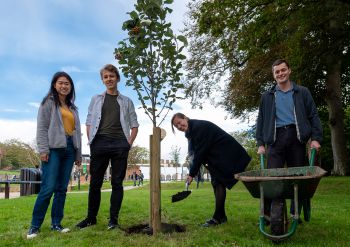
Student Connectors Yonnie Pang and Kamil Czarnecki, Prof Kelly Coate (Pro Vice Chancellor for Education and Students) and Connor Moylett (Student Living and Sustainability Officer at the Students' Union)
The University of Sussex will plant 60 trees as part of a year-long celebration of its 60th birthday.
The first of the trees – a native whitebeam - was planted on Monday (October 4), 60 years since the first intake of 52 students began their studies.
The tree-planting ceremony will kick off a programme of reunions, exhibitions, talks and walking tours over the next twelve months to celebrate Sussex's founding as part of a new, post-war generation of plate glass universities.
Founded in 1961, the University was the first of a new wave of universities that were both distinctive from other UK institutions architecturally and in educational approach, with a focus on interdisciplinarity and fluidity between subjects.
Adam Tickell, Vice-Chancellor of the University of Sussex, said: "The University was founded as an upstart to the centuries-old institutions in the UK and to offer something new, approaching Higher Education with different philosophies and methodologies. We've sought to maintain that disrupter ethos ever since and it is at the heart of who we are as a university today.
"The next year will serve as an opportunity to honour the University's legacy and the incredible people who helped to make it what it is but it will also act as a spur for us all to go on to even greater achievements, both individually and collectively, and burnish that legacy further."
During its first 60 years, the University has employed five Nobel Prize winners (Sir Anthony Leggett, Sir Paul Nurse, Archer Martin, Sir John Cornforth and Sir Harry Kroto) and a winner of the prestigious Crafoord Prize in John Maynard Smith.
Its growing list of notable alumni includes global leaders, scientists, writers, artists, activists, politicians, journalists, diplomats and historians.
Among the events already scheduled to mark the anniversary are:
Better World 60th Anniversary Event – Scheduled to be held on Wednesday 20 October at the Attenborough Centre of the Creative Arts where some of our leading academics, including Dr Mika Peck who is co-leading on our Sussex Kelp Forest Restoration Project, and talented graduate Lucy Hughes, winner of the 2019 James Dyson Award, will discuss their work around sustainability.
Programme celebrating black alumni who studied at the University of Sussex - The programme includes a series of portraits taken by photographer Charlie Phillips as well as talks and events reflecting on black experiences at the University of Sussex. The University will also be marking the achievements of Len Garrison, the founder of Black Cultural Archives (and former University of Sussex student).
60th anniversary event in the House of Lords – Event scheduled to be held in Parliament on Thursday 5 May 2022.
Harry Kroto plaque unveiling – Ceremony to be held on Friday 17 June marking the achievements of one of Sussex's Nobel-winners who was awarded the prestigious honour in 1996 for his work with Robert Curl and Richard Smalley in discovering fullerenes.
Summer Graduation – An opportunity for students who missed out on their in-person ceremony because of the Covid pandemic to celebrate their graduation with friends and families.
Alumni reunion weekend – A wide range of events planned for the weekend of September 3-4 2022 as university alumni are invited back on campus including in person and online events, an evening reception and disco as well as tours, walks and sporting activities.






